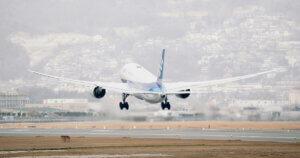
Ground effect
Discover how this ground effect is generated in aircraft and how to control it on a flight if you are a pilot. Learn how to avoid the well-known balloon effect.
Airbus’ latest Global Market Forecast (GMF) report for the period 2021-2040 provides a forward-looking view of air traffic and the evolution of fleet patterns.
This analysis takes into account factors such as demographic and economic development, tourism trends, as well as air cargo, aircraft efficiency, sustainability, energy prices and airline network development.
The report highlights strong future traffic and aircraft demand growth despite the adversities experienced, especially in the 100+ seat category, as well as a service forecast for the next 20 years.
This Airbus global market forecast serves as a benchmark for airlines, airports, suppliers, investors, governments, non-governmental agencies and others.
It anticipates that demand for air traffic and associated services will continue to develop as air traffic begins to return to pre-crisis levels.
Over the next 20 years, Airbus forecasts significant growth in air transport demand worldwide, generating a need for 39,000 new commercial aircraft and freighters.
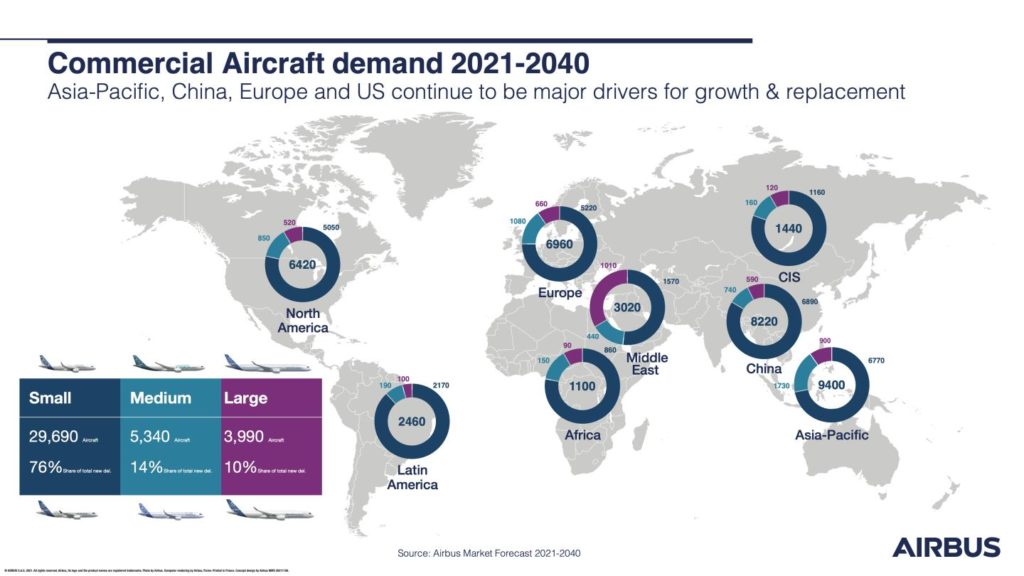
The economic impact of aviation on our society is extraordinary, contributing around 4% of annual global GDP and supporting some 90 million jobs worldwide.
We have experienced, due to the crisis generated by the impact of Covid-19, a situation unprecedented in history, which has completely shaken the foundations of any economy, forecasts and productive expectations in all sectors worldwide.
We have lost two years of growth during the COVID period, but despite the difficulties passenger traffic has proved resilient and is poised to reconnect at an annual growth of 3.9% per year, driven by expanding economies and trade worldwide, including tourism. The middle classes, more likely to fly, will grow over the next few years by two billion people to 63% of the world’s population.
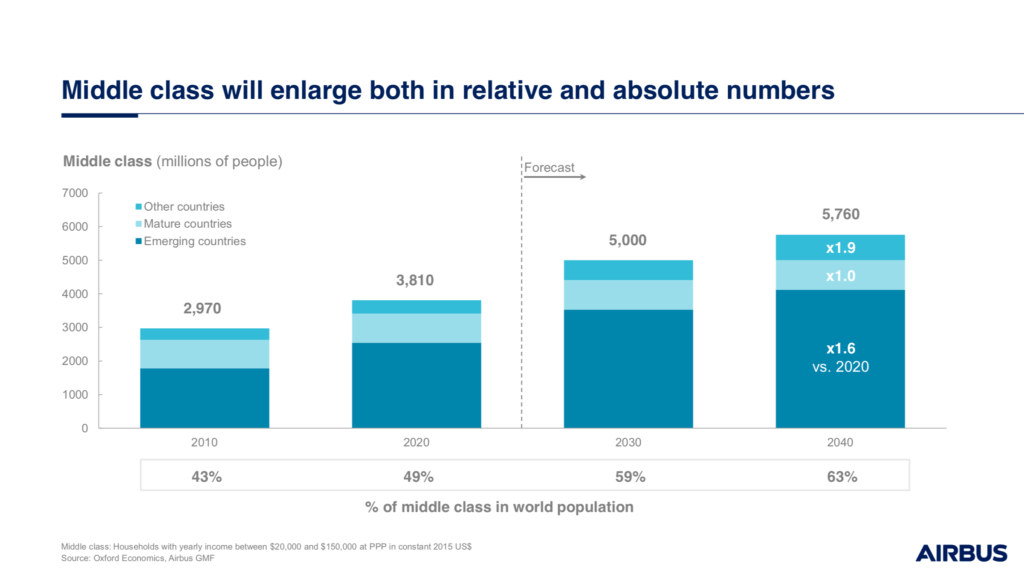
On the other hand, demand in the freight sector, driven by the steady growth of e-commerce, is driven by an expected growth in express transport of 4.7% per annum and a growth in general transport (which accounts for about 75% of the market) of 2.7%. In total, some 2,440 freighters will be needed over the next 20 years, of which 880 will be newbuilds.
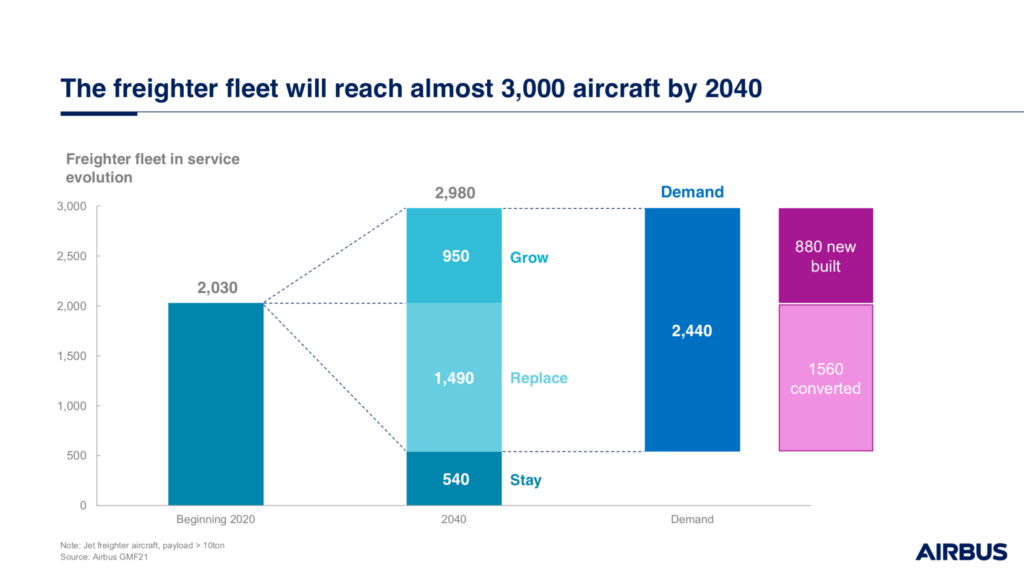
Airbus is betting on a full recovery of our industry to pre-COVID levels between 2023 and 2025, undoubtedly led by the extraordinary demand for single-aisle commercial aircraft. The Company is therefore providing suppliers with an update of their production plans, giving visibility to schedule the necessary investments and ensure long-term capacity and production rate availability, in line with the expected recovery.
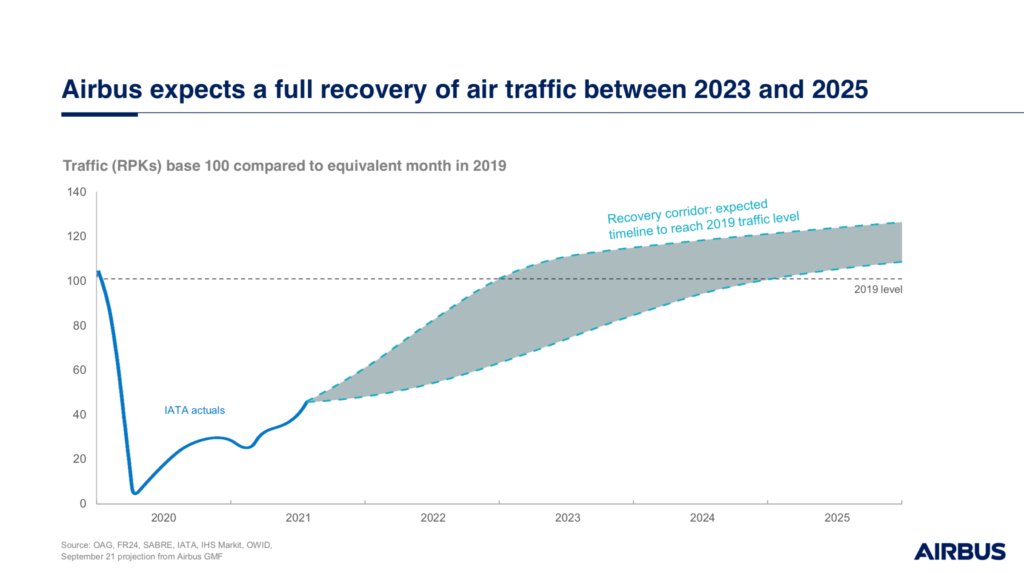
“The aviation industry is starting to recover from the COVID-19 crisis,” said Guillaume Faury, CEO of Airbus. “The message to our supplier community provides visibility to the entire industrial ecosystem to ensure the necessary capabilities and to be ready when market conditions require it. In parallel, we are transforming our industrial system by optimising the configuration of our structures and modernising our A320 Family production facilities. All these actions are put in place to prepare our future”.
This growth is well on track to the pre-pandemic levels projected by Airbus, reaching a cumulative value of around US$ 4.8 trillion over the next 20 years.
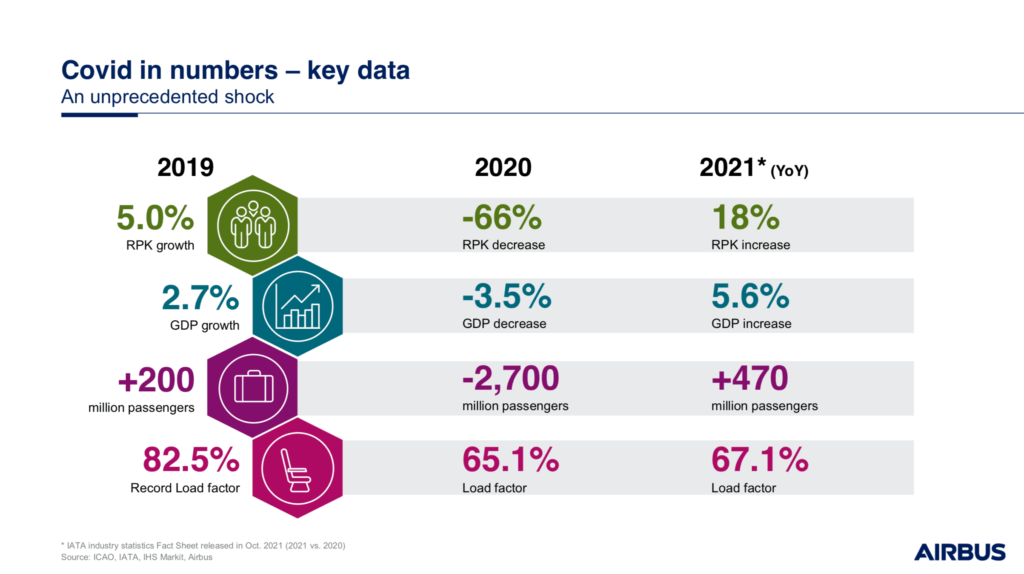
As the commercial aviation industry navigates an uneven global recovery from the recent market downturn caused by COVID-19, increasingly efficient aircraft operations globally increase the need for business aviation services, including maintenance, training, upgrades, flight operations, and of course training and training of qualified flight crews.
This expected global growth will dramatically boost the need for more than 600,000 new pilots, 650,000 new maintenance technicians and engineers, and more than 800,000 new cabin crew to support global commercial fleet needs over the next 20 years.
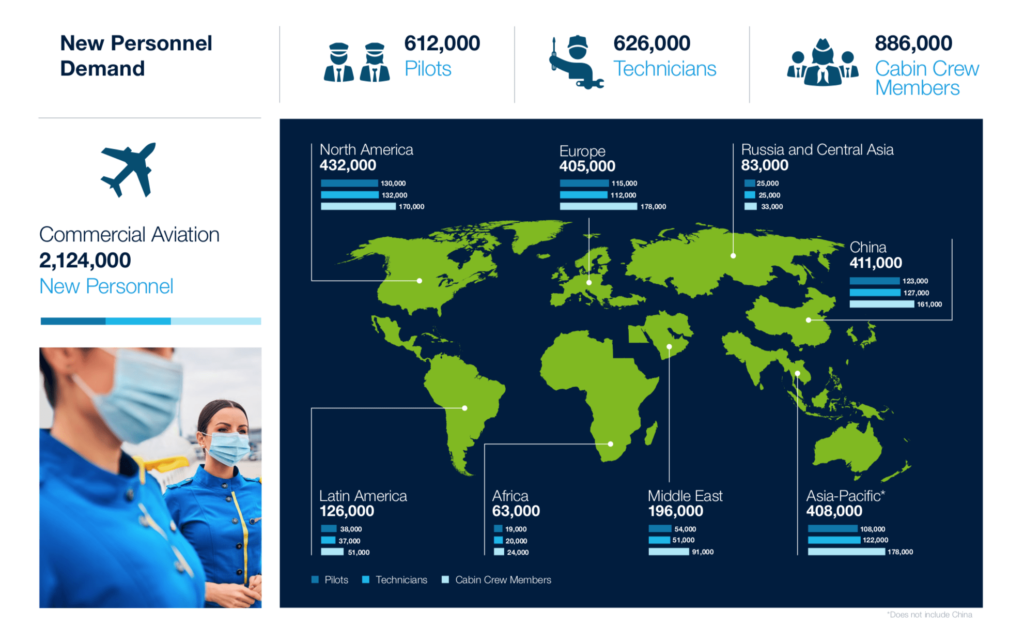
Meeting this projected demand forecast for pilots, technicians and engineers, and cabin crew depends entirely and directly on the industry’s investment in a steady flow of newly qualified and trained personnel to replace those who have left or will soon leave the industry, either through mandatory retirement, early retirement, recent redundancies due to the health crisis, or continuing departures.
The global aviation industry should maintain a sharp focus and engage in collective efforts to build a strong and diverse talent pipeline through increased training outreach, by investing in robust development of new aviation career pathways, facilitating investment in apprenticeship opportunities, and seeking the deployment and adoption of more efficient learning methods.
In the coming years, job opportunities for aspiring pilots will abound, while operators and airlines will face stiff competition to recruit and retain top talent, taking greater care than ever to nurture their human capital.
Those in the industry emerging from market downturns have historically resumed their growth trajectory through collaboration, adaptation and innovation. To address the challenges created during the COVID-19 pandemic, the training industry is adopting increasingly innovative solutions.
Many training and education providers have transitioned their offerings to virtual developments wherever and whenever possible, allowing learners to continue their learning securely and remotely, significantly shortening timelines, accelerating the learning curve and even improving their academic profile.
Immersive technologies, adaptive learning and flexible distance learning methods have allowed the flow of training to remain intact while evolving the way it is delivered. Continued investment in these technologies is likely to lead to a fundamental long-term change in the way training is conducted.
Training methodologies also continue to move towards a holistic approach that focuses on competencies rather than prescriptive tasks. As commercial operators and training providers look to the future, we expect to see continued investments in artificial intelligence, machine learning and mixed reality technology that will help tomorrow’s learners close their knowledge gaps faster, more efficiently and effectively. This will lead to a better, safer and more efficient aviation industry.
Prior to the COVID-generated industry slowdown, the industry was heading towards an unprecedented global pilot shortage and many airlines had begun using cadet pilot programmes to build their talent pipeline and have a steady flow of uninterrupted guarantees.
Some of these programmes have been halted or cancelled during this period of instability, but it is critical that operators refocus on developing and training new pilots.
Many inexperienced pilots lost their jobs last year, leading many of them to change careers and leave the industry altogether, rethinking their professional futures.
At the same time, many experienced pilots faced with job uncertainty accepted voluntary early retirement packages, and many pilots who have decided to remain active will soon be unable to fly commercial airlines due to the large volume of pilots worldwide approaching retirement age.
With the double whammy of a smaller pool of trained pilots and accelerated retirements, the pilot shortage is expected to be extraordinary, creating strong competition for qualified pilots over the next few years. New pilots starting their training now will soon benefit from continuing to increase their hours through flight training and will be well positioned to benefit from new opportunities in the commercial market when the time comes, with the experience required to qualify for an Airline position.

The past year has been one of uncertainty and change. Airline network planning and scheduling teams have struggled to adapt to more dynamic market conditions as flight bookings became more spontaneous and crew availability was affected by quarantine measures.
The scheduling of flight training will continue to be a constant challenge, as surges in air traffic demand will be accompanied by the aforementioned large number of retirements, generating new pilot hires, which coupled with the revival of the sector will facilitate a greater number of opportunities for instructors, experienced pilots, and inexperienced pilots.
We must look to the future with optimism, a solid industry that despite the instability, has demonstrated a solid resilience to probably the biggest impact in its history, where over the next 20 years, it is predicted that 612,000 new pilots will be needed to meet the demand of commercial airlines.
At World Aviation Flight Academy we are aware of the importance of quality training to meet the market opportunities in the near future, that is why we take care to listen and understand the needs of each of our students, putting at their disposal all our knowledge to provide the best training. We focus on the student as an absolute priority. We support their journey and training on an ongoing basis to ensure that they pass every stage.
Our pilot school works for the professional excellence of each student.
We are accompanied by instructors with more than 20 years of experience and state-of-the-art aircraft.
We offer:
Helicopter Pilot Courses
Aeroplane Pilot Courses
Drone Pilot Courses
Flying Experiences

Discover how this ground effect is generated in aircraft and how to control it on a flight if you are a pilot. Learn how to avoid the well-known balloon effect.
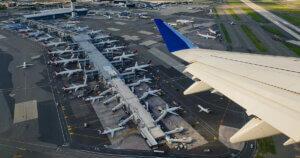
Every airport in the world has a three-digit code and they are called IATA codes. They are essential for the planning of a pilot, do you know them?
You will be up to date with the news at World Aviation Group.